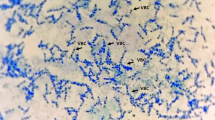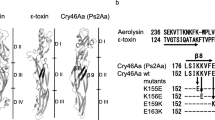Abstract
Three mutants were isolated from ethyl-methanesulfonate-treatedBacillus thuringiensis subsp.israelensis ONR-60A strain. The mutants were chosen from 200 colonies on the basis of crystal production and differed from the parent strain in plasmid pattern. Under an electron microscope, the parent strain and one of three mutants, il069-3, appeared to produce at least two distinct crystal sizes. The il042-8 mutant showed only small crystals, and no crystals were seen in the il069-9 mutant. Bioassay revealed that the parent strain and il069-3 had high mosquitocidal activity, but il042-8 and il069-9 appeared to be nontoxic to mosquito larvae. When crystal proteins were extracted in NaOH at pH 10 with 2% 2-mercaptoethanol (NaOH-MeEtOH) and analyzed by two-dimensional electrophoresis, the parent strain showed a complex protein composition in a molecular weight range of 10,000–120,000. The il069-3 crystals had a protein profile similar to that of the parent strain, but lost some proteins with high molecular weights. Both the parent strain and the il069-3 mutant produced 28-and 38-kilodalton (kdal) proteins as major components. The il042-8 mutant retained the 38-kdal protein, but was lacking the 28-kdal protein, and no significant amount of protein was seen in the extract of il069-9. The results from protein analysis and bioassay strongly indicate that the toxicity is associated with the 28-kdal protein. To, prove this, the protein was isolated by Sephacryl S-200 column chromatography and tested against mosquito larvae.
Similar content being viewed by others
Literature Cited
Bordier, C., Crettol-Järvinen, A. 1979. Peptide mapping of heterogeneous protein samples; Journal of Biological Chemistry254:2565–2567.
Goldberg, L. J., Margalit, J. 1977. A bacterial spore demonstrating rapid larvicidal activity againstAnopheles sergentii, Uranotaenia unguiculata, Culex univitattus, Aedes aetypti andCulex pipiens. Mosquito News37:355–358.
Gonzalez, Jr., J. M., Carlton, B. C. 1982. Plasmid transfer inBacillus thuringiensis. pp. 85–95, In: Streips, U. N., Goodgal, S. H., Guild, W. R., Wilson, G. A. (eds.), Genetic exchange, a celebration and a new generation. New York, Basel: Marcel Dekker, Inc.
Iizuka, T., Faust, R. M., Travers, R. S. 1980. Isolation and partial characterization of extrachromosomal DNA from serotypes ofBacillus thuringiensis pathogenic to lepidopteran and dipteran larvae by agarose gel electrophoresis. Journal of Sericultural Science of Japan50:120–133.
Iizuka, T., Yamamoto, T. 1983. Possible location of the mosquitocidal protein in the crystal preparation ofBacillus thuringiensis subsp.kurstaki. FEMS Microbiology Letters19:187–192.
Lüthy, P. 1980. Insecticidal toxins ofBacillus thuringiensis. FEMS Microbiology Letters8:1–7.
Ramoska, W. A., Hopkins, T. L. 1981. Effects of mosquito larval feeding behavior onBacillus sphaericus efficacy. Journal of Invertebrate Pathology37:269–272.
Thomas, W. E., Ellar, D. J. 1983.Bacillus thuringiensis var.israelensis crystal δ-endotoxin: effects on insect and mammalian cellsin vitro andin vivo. Journal of Cell Science60:181–197.
Tyrell, D. J., Bulla, Jr., L. A., Andrews, Jr., R. E., Kramer, K. J., Davidson, L. I., Nordin, P. 1981. Comparative biochemistry of entomocidal parasporal crystals of selectedBacillus thuringiensis strains. Journal of Bacteriology145:1052–1062.
Yamamoto, T. 1983. Identification of entomocidal toxins ofBacillus thuringiensis by high performance liquid chromatography. Journal of General Microbiology129:2595–2603.
Yamamoto, T., McLaughlin, R. E. 1981. Isolation of a protein from the parasporal crystal ofBacillus thuringiensis var.kurstaki toxic to the mosquito larva,Aedes iaeniorhynchus. Biochemical and Biophysical Research Communications103:414–421.
Author information
Authors and Affiliations
Additional information
Mention of a commerical product does not constitute recommendation for use by the US Department of Agriculture.
Rights and permissions
About this article
Cite this article
Yamamoto, T., Lizuka, T. & Aronson, J.N. Mosquitocidal protein ofBacillus thuringiensis subsp.israelensis: Identification and partial isolation of the protein. Current Microbiology 9, 279–284 (1983). https://doi.org/10.1007/BF01567201
Issue Date:
DOI: https://doi.org/10.1007/BF01567201




